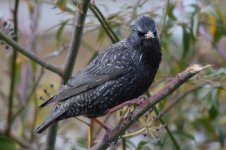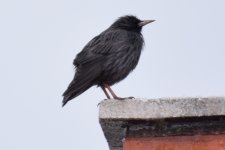You explain moult but not how to differentiate, 'Collins' states that 'usually', Spotless doesn't have spotting on the head as the first bird does.
I'm going to disagree and stick with vulgaris for one.
True, that my explanation was not too detailed.
So I'm going to rely on my personal experience and some bibliography to support my ID, mostly for bird 1, since bird 2 ID doesn't pose much doubt.
S. unicolor, have a duller iridescence when compared with S. vulgaris (Blasco-Zumeta & Heinze 2018, Svensson et al. 2009, Shirihai & Svensson 2018). Bird 1 is rather duller.
S. unicolor, in winter plumage, have smaller/duller white tips of feathers when compared with S. vulgaris (Blasco-Zumeta & Heinze 2018). Bird 1 has smaller spots relatively to the size I would expect to see on S. vulgaris.
S. unicolor, lacks (or have very thin) paler fringes of wing flight feathers/ and some coverts; by contrast, S. vulgaris show broader buff fringes in these feathers (Blasco-Zumeta & Heinze 2018, Svensson et al. 2009). Bird 1 fits S. unicolor description for this feature.
Shirihai & Svensson (2018) refer bill shape/size, leg colour and hackle size also as features used to differentiate between these too species. These are hard to assess in picture 1. Blasco-Zumeta & Heinze (2018) also mention wing formula which I think we can agree it's useless in this picture 1.
Two links which I think are helpful:
http://blascozumeta.com/wp-content/uploads/aragon-birds/passeriformes/416.starling-svulgaris.pdf
http://blascozumeta.com/wp-content/...seriformes/417.spotlessstarling-sunicolor.pdf
Also I'd like to ask if SLopezM could state the date of the pictures.
Ref:
Blasco-Zumeta, J.F., Heinze, G.-M., 2018. Identification Atlas of Aragon’s Birds. URL
http://blascozumeta.com/atlas-de-aves/ (accessed 12.7.18).
Shirihai, H., Svensson, L., 2018. Handbook of Western Palearctic Birds: Passerines.
Svensson, L., Mullarney, K., Zetterström, D., 2009. Collins bird guide, Second edition.






